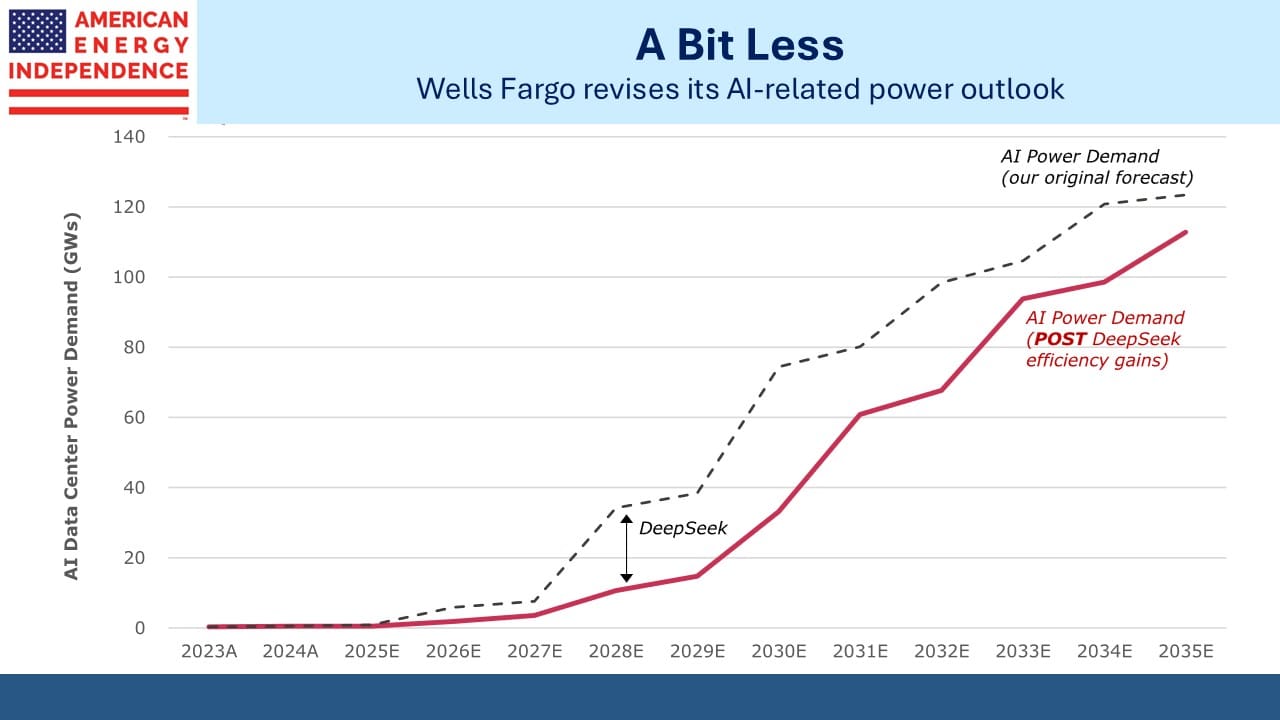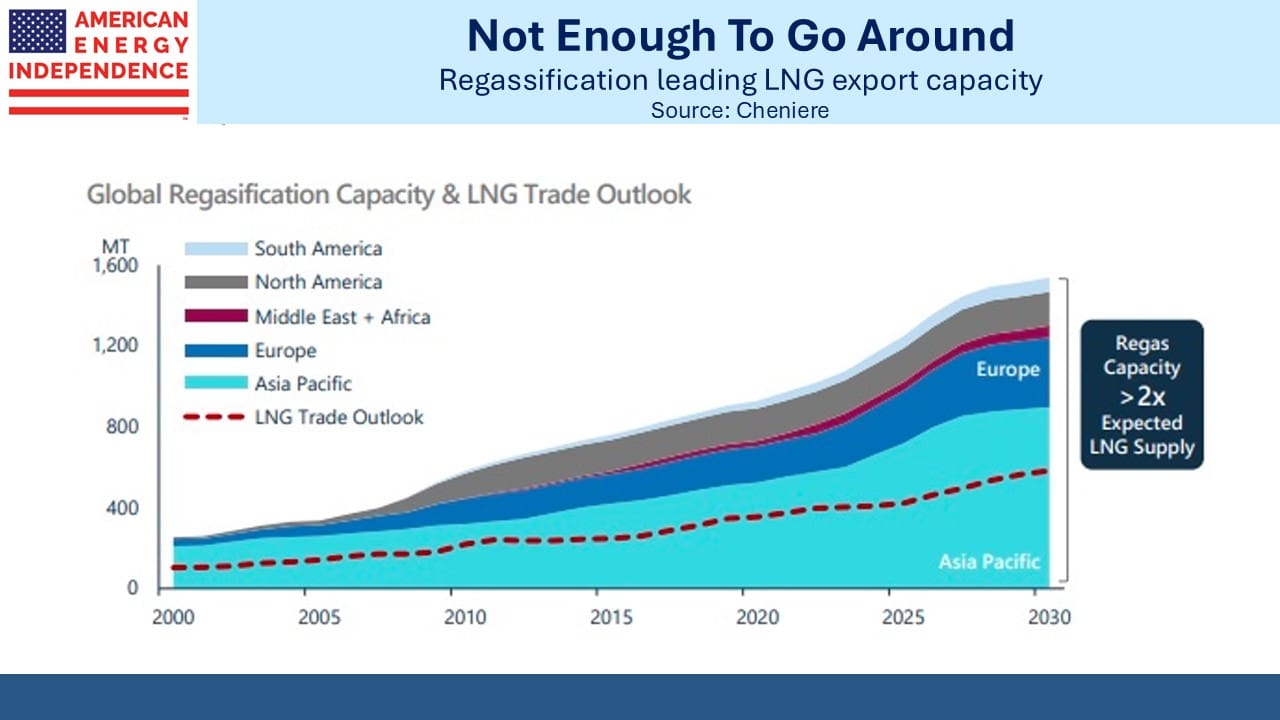Pipelines And The Jevons Paradox

/
Venture capitalist Marc Andreessen called it, ”AI’s sputnik moment.” The news that Chinese start-up Deepseek may have leapt ahead of the US in AI caused an unpleasant start to the week. In 1957 Sputnik’s orbit led to the creation of NASA and fears that Russian satellites could attack the US from space. While Americans have not yet been moved to gaze skyward for Chinese AI-powered threats, its impact was felt by AI-linked sectors of the stock market.
Natural gas pipeline stocks that have enjoyed a tailwind from anticipated data center power demand dropped sharply. At such times it’s worth reviewing valuation and the underlying fundamentals.
The yield on the American Energy Independence Index (AEITR) recently fell below 5% as pipeline stocks continued to appreciate. Last year’s 45% total return was well in excess of cash flow growth but yields at the start of last year were unreasonably high.
Distributable Cash Flow (DCF) yields on the largest pipeline stocks are above 11%, providing ample payout coverage. Some of the lowest-yielding stocks have the highest coverage. For example, Williams Companies yielded 3.6% after its stock dropped almost 10% on Monday. But its DCF yield rose to 7.8%, more than 2X its payout and expected to grow at 7-8% into 2026. They raised their dividend on Tuesday by 5.6%. Kinder Morgan’s (KMI) yield rose to 4.2%, also more than 2X covered by its 8.6% DCF yield.
The data center story boosted both stocks over the past year. Even so, last week’s KMI earnings call was not dominated by AI expectations, with only a couple of questions on the topic which CEO Kim Dang referred to as, “singles and doubles, connecting to power plants, that types of things.”
Energy Transfer’s yield rose to 7%, higher than the sector since it trades at an MLP discount. Its DCF is almost 2X its payout yield at 13.9%. On Monday they announced a 1.6% increase.
Investors will want to assess how much data center power demand is reflected in current valuations. The capex numbers being floated for construction have been startling. Just last week Mark Zuckerberg said Meta could spend up to $65BN this year to achieve its AI goals.
Microsoft (MSFT) expects to spend $80BN this year on data centers. Meta’s stock even rose on the news, as investors contemplated that less compute-intensive AI development could boost free cash flow.
MSFT CEO Satya Nadella tweeted that the Jevons’ paradox could apply, in which efficiency improvements raise overall demand. Perhaps a breakthrough in training AI models will boost their penetration, which could drive power demand even higher than recent projections. DeepSeek’s insights will spread across the industry since it’s open source. It seems incongruous to conclude that better AI will reduce its use or its demand for reliable power.
Wells Fargo expects that the computational improvements demonstrated by DeepSeek will slow near term power demand but still sees 11 Billion Cubic feet per Day (BCF/D) of additional natural gas consumption by 2035, down modestly from their previous forecast of 12 BCF/D. Still, it’s not often that a single news development results in an altered ten year outlook.
It’s worth remembering that data centers only caught investors’ attention last year. The outlook for natural gas demand was already strong based on rising living standards in developing countries. LNG offers both sellers and buyers flexibility versus pipelines, and the US is increasing its lead as the #1 exporter.
The world is preparing to buy more. Regassification capacity, which enables importers to turn LNG back into a usable gaseous form, is growing faster than supply. For every Billion Cubic Feet (BCF) the US exports, there will be 2 BCF of regassification available. These projects were not predicated on data centers. The fundamentals for traditional energy remain sound.
Enduring such market corrections is never pleasant. They’re rarely over in a day, but history shows that eventually judgment on valuations prevails and prices respond. One good development is that forced selling from MLP closed end funds isn’t likely to depress prices much. These hapless managers including Tortoise, Kayne Anderson and Goldman Sachs destroyed enough capital during the pandemic-induced collapse that they’re now of inconsequential size (see MLP Closed End Funds – Masters Of Value Destruction).
Recent market action reminds why adding leverage to an undiversified portfolio of stocks simply betrays the hubris of the portfolio manager at the expense of the investors.
The worst performance came from Venture Global which began trading on Friday after pricing its IPO at $25, which we felt was too high (see Nothing Ventured, Nothing Gained). On Tuesday it traded below $18, down 28% over two days and far worse than AI darling Nvidia.
Regardless of the outlook for domestic power demand, growing US gas exports will require a doubling of the natural gas pipelines supply to liquefaction terminals over the next four years. The regulatory environment will be more conducive to growing the production and movement of hydrocarbons. Energy is the president’s favorite sector.
AI is far from the whole story.
We have two have funds that seek to profit from this environment:

Important Disclosures
The information provided is for informational purposes only and investors should determine for themselves whether a particular service, security or product is suitable for their investment needs. The information contained herein is not complete, may not be current, is subject to change, and is subject to, and qualified in its entirety by, the more complete disclosures, risk factors and other terms that are contained in the disclosure, prospectus, and offering. Certain information herein has been obtained from third party sources and, although believed to be reliable, has not been independently verified and its accuracy or completeness cannot be guaranteed. No representation is made with respect to the accuracy, completeness or timeliness of this information. Nothing provided on this site constitutes tax advice. Individuals should seek the advice of their own tax advisor for specific information regarding tax consequences of investments. Investments in securities entail risk and are not suitable for all investors. This site is not a recommendation nor an offer to sell (or solicitation of an offer to buy) securities in the United States or in any other jurisdiction.
References to indexes and benchmarks are hypothetical illustrations of aggregate returns and do not reflect the performance of any actual investment. Investors cannot invest in an index and do not reflect the deduction of the advisor’s fees or other trading expenses. There can be no assurance that current investments will be profitable. Actual realized returns will depend on, among other factors, the value of assets and market conditions at the time of disposition, any related transaction costs, and the timing of the purchase. Indexes and benchmarks may not directly correlate or only partially relate to portfolios managed by SL Advisors as they have different underlying investments and may use different strategies or have different objectives than portfolios managed by SL Advisors (e.g. The Alerian index is a group MLP securities in the oil and gas industries. Portfolios may not include the same investments that are included in the Alerian Index. The S & P Index does not directly relate to investment strategies managed by SL Advisers.)
This site may contain forward-looking statements relating to the objectives, opportunities, and the future performance of the U.S. market generally. Forward-looking statements may be identified by the use of such words as; “believe,” “expect,” “anticipate,” “should,” “planned,” “estimated,” “potential” and other similar terms. Examples of forward-looking statements include, but are not limited to, estimates with respect to financial condition, results of operations, and success or lack of success of any particular investment strategy. All are subject to various factors, including, but not limited to general and local economic conditions, changing levels of competition within certain industries and markets, changes in interest rates, changes in legislation or regulation, and other economic, competitive, governmental, regulatory and technological factors affecting a portfolio’s operations that could cause actual results to differ materially from projected results. Such statements are forward-looking in nature and involves a number of known and unknown risks, uncertainties and other factors, and accordingly, actual results may differ materially from those reflected or contemplated in such forward-looking statements. Prospective investors are cautioned not to place undue reliance on any forward-looking statements or examples. None of SL Advisors LLC or any of its affiliates or principals nor any other individual or entity assumes any obligation to update any forward-looking statements as a result of new information, subsequent events or any other circumstances. All statements made herein speak only as of the date that they were made. r
Certain hyperlinks or referenced websites on the Site, if any, are for your convenience and forward you to third parties’ websites, which generally are recognized by their top level domain name. Any descriptions of, references to, or links to other products, publications or services does not constitute an endorsement, authorization, sponsorship by or affiliation with SL Advisors LLC with respect to any linked site or its sponsor, unless expressly stated by SL Advisors LLC. Any such information, products or sites have not necessarily been reviewed by SL Advisors LLC and are provided or maintained by third parties over whom SL Advisors LLC exercise no control. SL Advisors LLC expressly disclaim any responsibility for the content, the accuracy of the information, and/or quality of products or services provided by or advertised on these third-party sites.
All investment strategies have the potential for profit or loss. Different types of investments involve varying degrees of risk, and there can be no assurance that any specific investment will be suitable or profitable for a client’s investment portfolio.
Past performance of the American Energy Independence Index is not indicative of future returns.




Leave a Reply
Want to join the discussion?Feel free to contribute!